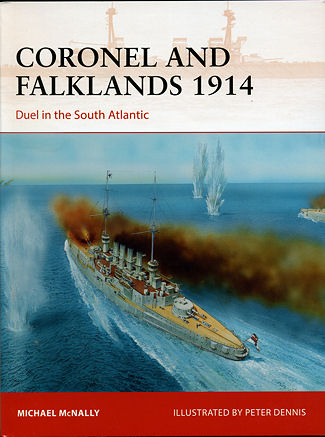 Just
like in WWII, one of the earliest naval actions took place in the waters around
South America. Prior to WWI, Germany had a number of overseas possessions and
like many of the European powers, had a small fleet in being operating in China.
In this case, it was a small fleet of cruisers and auxiliaries commanded by
Admiran von Spee. Once war in Europe was underway, von Spee knew it would only
be a matter of time before Japan got involved and he did not want to have his
ships sunk or bottled up in a Chinese port. So one day, the ships, fully
provisioned and will colliers in tow, headed out into the Pacific.
Just
like in WWII, one of the earliest naval actions took place in the waters around
South America. Prior to WWI, Germany had a number of overseas possessions and
like many of the European powers, had a small fleet in being operating in China.
In this case, it was a small fleet of cruisers and auxiliaries commanded by
Admiran von Spee. Once war in Europe was underway, von Spee knew it would only
be a matter of time before Japan got involved and he did not want to have his
ships sunk or bottled up in a Chinese port. So one day, the ships, fully
provisioned and will colliers in tow, headed out into the Pacific.
This began a bit of a search for von Spee's squadron by
British and Commonwealth forces. Thanks to the British penchant for keeping
their warships for convoy escort, those ships in the area that could hunt down
von Spee were involved in escorting the Australians and New Zealanders in the
short campaigns against German island possessions. This allowed von Spee to not
only stop for provisions at various Pacific islands, but also to keep ahead of
any pursuing vessels.
The British knew that von Spee would be heading for the Atlantic
where his ships could do the most damage to British shipping. As such, they
gathered a small squadron of ships in the Falklands under Admiran Craddock.
However, his ships were not first rate, consisting of some cruisers, armed
liners and one old, slow battleship. These ships were expected to do battle with
some of the best trained gunnery crews around that were aboard the German
armored cruisers.
To cut a long story a bit short. The Germans pulled into
Valparaiso for provisions and it was there that word went out to the Admiralty
as to the location of von Spee's fleet. Despite a request for larger and faster
ships, Craddock did not get them. So he took his squadron into the Pacific.
Originally thinking that he was chasing but a single ship, Craddock soon got
into a battle with von Spee's squadron outside the harbor of Coronel. Most of
his small squadron was destroyed by the superior German gunnery and that
included Craddock and his flagship.
By this time, the Admiralty had realized that more was needed
so sent a pair of new battle cruisers to the Falklands. Meanwhile, von Spee had
decided to try to destroy the coaling station in the Falklands. His scouting
ships saw the British fleet in port undergoing maintenance and re-coaling.
Instead of immediately attacking, which may well have done serious damage to the
British, von Spee's fleet held off. Eventually the British came out to fight.
Though the Germans fought valiantly, they were eventually overwhelmed by the
larger guns of the British battle cruisers.
It is somewhat ironic that 25 years later, a German ship
bearing von Spee's name would also be involved with a British fleet in South
Atlantic waters.
In all, the book is superbly written, holding one's attention
throughout. Excellent period photos of the men and ships involved, combined with
the outstanding art work of Peter Dennis makes these events come alive. It is
one of Osprey's best and a book that you can buy with confidence. Most highly
recommended.
December 2012
For more on the complete line of Osprey books,
visit www.ospreypublishing.com. In the US, it is
Osprey Direct at 44-02 23rd St, Suite 219, Long Island City, NY 11101., where you can
get a catalogue of available books.
If you would like your product reviewed fairly and fairly quickly, please contact
the editor or see other details in the
Note to
Contributors.
 Just
like in WWII, one of the earliest naval actions took place in the waters around
South America. Prior to WWI, Germany had a number of overseas possessions and
like many of the European powers, had a small fleet in being operating in China.
In this case, it was a small fleet of cruisers and auxiliaries commanded by
Admiran von Spee. Once war in Europe was underway, von Spee knew it would only
be a matter of time before Japan got involved and he did not want to have his
ships sunk or bottled up in a Chinese port. So one day, the ships, fully
provisioned and will colliers in tow, headed out into the Pacific.
Just
like in WWII, one of the earliest naval actions took place in the waters around
South America. Prior to WWI, Germany had a number of overseas possessions and
like many of the European powers, had a small fleet in being operating in China.
In this case, it was a small fleet of cruisers and auxiliaries commanded by
Admiran von Spee. Once war in Europe was underway, von Spee knew it would only
be a matter of time before Japan got involved and he did not want to have his
ships sunk or bottled up in a Chinese port. So one day, the ships, fully
provisioned and will colliers in tow, headed out into the Pacific.